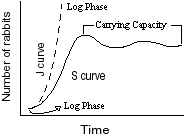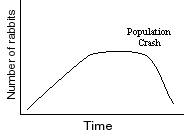The answer to the question on the previous page is:
Cellular Respiration
C6 H12 O6 + 6 O2 --------------> 6 CO2 + 6 H2 OPhotosynthesis
6 CO2 + 6 H2 O --------------> C6 H12 O6 + 6 O2Note: The same gases are used in both reactions.
Read the following statements and indicate if they are true or false. If false expalin why they are not true.
Plants carry on both photosynthesis and cellular respiration. (True/ False)
Oxygen used by animals (humans) for cellular respiration comes from plants through the process of photosynthesis. (True/ False)
The amount of oxygen produced by a plant during photosynthesis is the same amount the plant uses during cellualar respiration. (True/ False)
High concentrations of carbon dioxide is toxic to both plants and animals. (True/ False)
 In
a very real sense we are as much captives of Earth as you will be in your
spaceship Big Blue during the trip. In fact, we must depend on Spaceship
Earth’s support systems for as long as we live. All the air we breathe,
the water we drink, and all the food we eat are the results of delicate
natural systems that can easily be altered. During your voyage, you will
have to function within the limits and capacity of your support system,
and so must we.
In
a very real sense we are as much captives of Earth as you will be in your
spaceship Big Blue during the trip. In fact, we must depend on Spaceship
Earth’s support systems for as long as we live. All the air we breathe,
the water we drink, and all the food we eat are the results of delicate
natural systems that can easily be altered. During your voyage, you will
have to function within the limits and capacity of your support system,
and so must we.
If there were unlimited resources on earth the rate of natural growth of populations would become logarithmic. However this is not the case. Even the human population living in the city shown above do not have unlimited resources. Read the pages indicated by Z-0 and study behavioral objective 2. Write in your notes a definition of populations and communities in relation to an ecosystem. The size of a population is the result of two factors that are kept in balance. One is the biotic potential (maximum rate of increase in population growth) and the other is environmental resistance. Write a paragraph describing how environmental resistance and exponential growth form the various parts of a growth curve. Examine the various parts of a growth curve below and identify the parts of the J-shaped and S-shaped curve.
 Let us examine
a growth curve of a population of rabbits in a confined valley. Initial
growth is called the lag phase (line at the beginning) which will eventually
increase into a logarithmic phase. Because of unlimited resources the logarithmic
phase(dotted line on J curve) will level off and may decline or fluctuate.
This growth curve is called a S-shaped curve. If the population of rabbits
density remains constants at this point, this would show the carrying
capacity for rabbits in the valley.
Let us examine
a growth curve of a population of rabbits in a confined valley. Initial
growth is called the lag phase (line at the beginning) which will eventually
increase into a logarithmic phase. Because of unlimited resources the logarithmic
phase(dotted line on J curve) will level off and may decline or fluctuate.
This growth curve is called a S-shaped curve. If the population of rabbits
density remains constants at this point, this would show the carrying
capacity for rabbits in the valley.
The rabbit population may not stabilize but show an abrupt decline in population growth with time. This is called a population crash (see figure below).
 There must be
a balance between the factors that increase the number of rabbits (biotic
potential) and the factors that limit the number of rabbits (environmental
resistance) to maintain a stable population density. What are some the
limiting factors that may keep the population density around a certain
point?
There must be
a balance between the factors that increase the number of rabbits (biotic
potential) and the factors that limit the number of rabbits (environmental
resistance) to maintain a stable population density. What are some the
limiting factors that may keep the population density around a certain
point?
- a. resource depletion
- b. competition
- c. predation
- d. disease
- e. all of these
- a. Population growth
- b. An increase in the number of plants.
- c. The sun is producing less energy.
- d. A decrease in the number of animals.
Created by the Multimedia Development Lab, Academic Technology Services.
Last modified November 19, 1997.